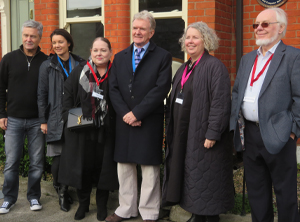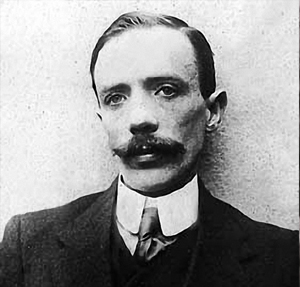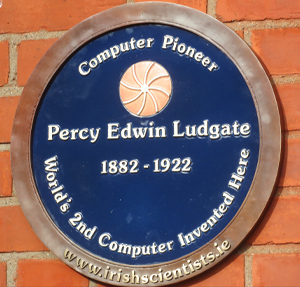CELEBRATING IRELAND’S COMPUTER SCIENCE PIONEERS
Published in Issue 1 (January/February 2023), News, Volume 31By Brian Smyth
The National Committee for Commemorative Plaques in Science and Technology (NCCPST) was formed in 1997 to celebrate achievements across science, technology, engineering and mathematics in Ireland. Over the past 25 years the committee has erected 75 plaques, and it aims to erect at least a further 125 to commemorate those who have made important contributions to their field.
Last year three Irish people who have made significant contributions to the development of computer science in Ireland and abroad were commemorated with plaques from the NCCPST—Percy Ludgate, who in 1909 published the world’s second design for a computer; Kay McNulty, a pioneer programmer of the 1940s ENIAC computer; and John Byrne, the highly influential first professor of computer science in this state. NCCPST has already commemorated George Boole (1815–64), another important person in the history of computing in Ireland, by erecting a plaque to him in the Mathematics Department of University College Cork.
Percy Edwin Ludgate (1883–1922) was born in Skibbereen, Co. Cork, in 1883. By 1890 his family had moved to Dublin, where he became a clerk to a corn merchant. Between 1903 and 1909 he worked on the design of his ‘analytical machine’ during his spare time (often past midnight) at his home at 30 Dargle Road, Drumcondra. He was unaware of Charles Babbage’s invention of the first mechanical computer until his initial design was completed. The design was published in the Scientific Proceedings of the Royal Dublin Society in 1909 and reviewed in Nature a few months later.
Percy Ludgate’s analytical machine was radically different from Babbage’s machine in that it was the first to be based on multiply-and-accumulate (MAC) using novel mechanical ideas, whereas Babbage’s machine was based on addition. MAC is an operation widely used in modern computers as well as in radar and other signal-processing, while Ludgate’s mathematics is now known as Irish Logarithms. Ludgate was then able to exploit MAC to do division as a series of these operations (another first). His storage mechanism was very novel, based on rods in shuttles within two concentric cylinders and able to randomly access stored values. Ludgate’s machine could be sequenced automatically through a series of operations using perforated paper, and it was able to change the sequencing mechanism based on prior calculations. The way it did these was much more like a modern computer than was Babbage’s. It was capable of doing everything a modern computer could do, albeit more slowly.
Ludgate subsequently studied accountancy at the Rathmines College of Commerce (later part of the Dublin Institute of Technology), qualifying with a gold medal in 1917, and then worked for a prominent Dublin accountancy firm. Commuting between his home in Drumcondra and his work in Dame Street, he is likely to have observed at first hand the 1916 Rising, the War of Independence and the Civil War.

Above: At the unveiling of the plaque to Percy Ludgate at 30 Dargle Road, Drumcondra, on 15 October 2022—Michael Mongan and Joan Hovenden (present owners of the house), Trish Gonzalez (descendent of Ludgate’s only niece), Prof. Gregory O’Hare (School of Computer Science and Statistics, TCD), Prof. Linda Doyle (Provost, TCD) and Prof. Brian Randell (School of Computing, Newcastle University). (Maurice O’Reilly)
Percy Ludgate died in 1922 and faded into obscurity until Brian Randall’s paper in 1971. In 1991 the Department of Computer Science in Trinity College, Dublin, instigated an annual prize in his memory, the only official recognition until 2016, when the Ludgate Hub, an incubation hub in Skibbereen, was named in his honour. The project was initiated under the aegis of the John Gabriel Byrne Computer Science Collection to explore and document Percy Ludgate’s life and work. One of the results has been the discovery of the only known contemporary drawings of part of his computer, which has enabled experts to gain new understandings of its operation.
A new book edited by Brian Coghlan and Brian Randell, published in 2022, gives information on Ludgate’s life and work and includes the results of previous investigations, along with Ludgate’s original papers. The NCCPST erected a plaque to Ludgate in October 2022 at his former home in Drumcondra, Dublin, funded by Trinity College, Dublin; it was unveiled by the provost, Prof. Linda Doyle, on 15 October 2022.
Dr Brian Smyth is the chair of the National Committee for Commemorative Plaques in Science and Technology and acknowledges assistance from committee members in writing this article.
Further reading
B. Coghlan and B. Randall (eds), Percy Ludgate (1883–1922), Ireland’s first computer designer (Dublin, 2022).
B. Randall, ‘Ludgate’s analytical machine of 1909’, Computer Journal 14 (3) (1971), 317–26.


















